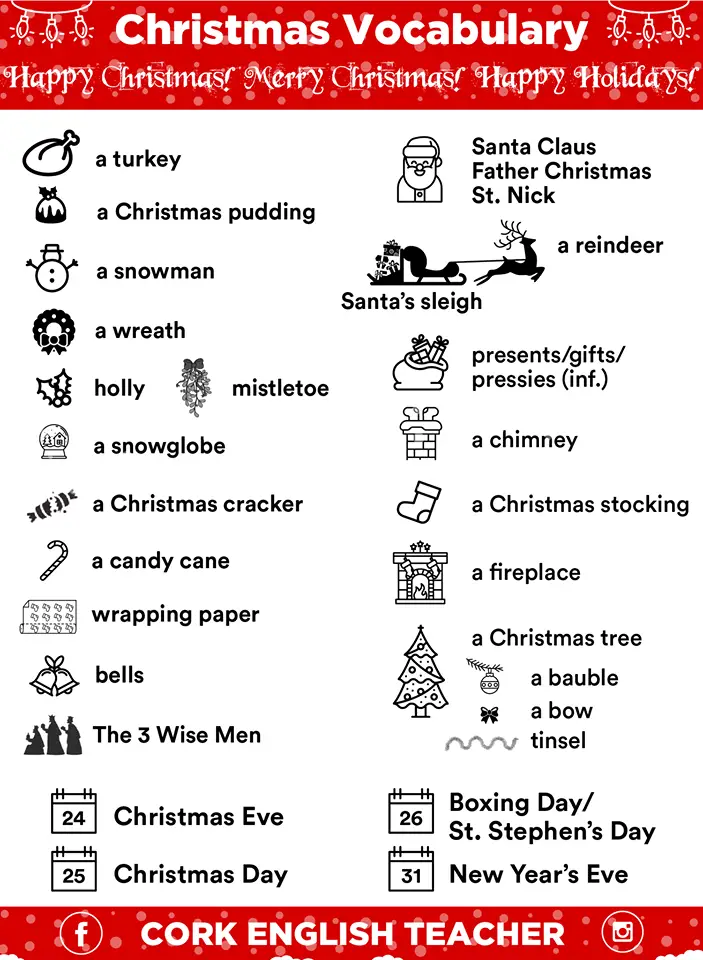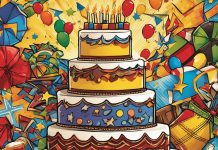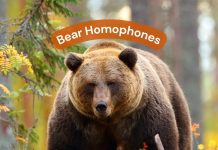- Basic Terms
- Commercial vocabulary
- Christmas food
- Christmas Characters
- Quiz with answers
- Christmas carols
“Twas the night before Christmas, when all thro’ the house
Not a creature was stirring, not even a mouse;
The stockings were hung by the chimney with care,
In hopes that St. Nicholas soon would be there…”
— “A Visit from St. Nicholas” by Clement Clarke Moore, 1823
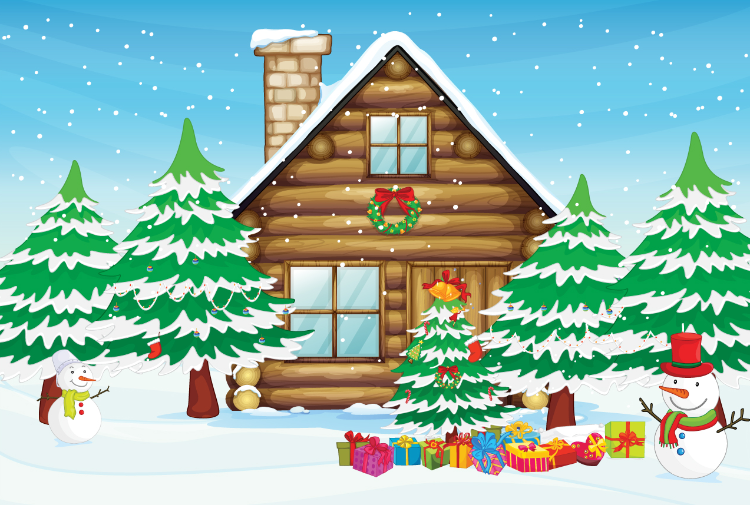
BASIC TERMS
CHRISTMAS
Christmas, pronounced /’krɪsməs/ or “kriss-miss,” is one of the most important holidays in Western (and especially American) culture, occurring on December 25th every year. Whether or not you’re a Christian, there’s no escaping the Christmas decorations, songs, wishes, and atmosphere that comes around each winter. And with this special (and over-exaggerated) holiday comes many vocabulary words that you should know in order to seem like a true, culturally aware English speaker.
CHRISTMAS EVE
The word “eve” is used to mean the day before a holiday. So, “Christmas Eve” refers to the day before Christmas. The other common holiday that uses the word “eve” is “New Year’s Eve.” For some families, Christmas Eve tends to be even more important than Christmas itself, and many people will have a special dinner and open their Christmas presents that night.
CHRISTMASTIME
Christmastime is pretty much what it sounds like – the time around Christmas. This exact frame of time can vary, although it usually includes Christmas Eve and New Year’s. You might know this word from the famous song “Christmas Time is Here” from the TV special “A Charlie Brown Christmas” (here, the word is spelled as two separate words).
MERRY CHRISTMAS, MERRY CHRISTMAS EVE
Although you usually wish somebody a good holiday with the word “happy,” (e.g. “Happy Valentine’s Day,” “Happy Thanksgiving”), it is not common to say “Happy Christmas.” Instead, people say, “Merry Christmas” or “Merry Christmas Eve.” Christmas is such a popular holiday that it even seems to have its own special greeting.
HAPPY HOLIDAYS
Nowadays, some people consider the greeting, “Merry Christmas” to be too much associated with Christianity. Therefore, a more “politically correct” greeting you can use is “Happy Holidays,” which encompasses all the holidays that happen around Christmastime, notably Hanukkah and Kwanzaa.
XMAS
Another way to de-Christianize Christmas is to take the word “Christ” out of the name. This results in the informal term “Xmas,” which is pronounced the way it looks (/’ɛksməs/).
YULE, YULETIDE
“Yule” or “Yuletide” is an archaic term for Christmas and is usually only used in songs. The name actually comes from an older Norse festival, but it later referred to Christmas due to Christian influences. The term “yule log” also comes from this name, which is a large log usually found in the fireplace on Christmas eve.
More for you:
112 Phrases for Saying Thank You in Any Situation
10 New Year Wishes and Useful Expressions to Spice Up the Holiday …
COMMERCIAL VOCABULARY
CHRISTMAS TREE
For most families, buying a Christmas tree is an important Christmas tradition. Usually, it’s an evergreen tree decorated with lights and ornaments that people put presents under to be opened on Christmas day. It’s such a core Christmas tradition that there’s even a song named after it (“O Christmas Tree”).
CHRISTMAS PRESENT/GIFT
A “Christmas present” (or gift) is one that is specifically given on Christmas. Christmas is one of the biggest holidays for gift-giving among friends and family, which is probably why holiday sales are such a big deal.
ORNAMENT
“Ornament” is another word for “decoration,” and in the context of Christmas, it is specifically a decoration used to adorn a Christmas tree. Christmas ornaments usually come in the form of shiny, metallic spheres that are hung off of the branches of Christmas trees. However, they’re notorious for falling and breaking easily.
WREATH
A wreath is a large ring of plants and flowers used for decoration. For example, the Greeks used to award laurel wreaths to the winners of competitions like the Olympic Games and were worn as crowns. Christmas wreaths, on the other hand, tend to be made out of evergreens and symbolize strength through the winter. You’ll often see them hung on people’s front doors.
CHRISTMAS LIGHTS, FAIRY LIGHTS
Christmas lights, or fairy lights, are wires of lights wrapped around trees and houses to decorate them, usually at night during the winter. Lately, they’re being used as decorations for school classrooms and dorm rooms, regardless of the season.
STAR, ANGEL
The most iconic part of a Christmas tree is the star that adorns the very top. It represents the star that the shepherds followed to find the baby Jesus in the Nativity story, and no Christmas tree is complete without it. However, it is sometimes replaced by an angel, which traditionally served a similar role of guiding people to Jesus.
STOCKING
Another common Christmas tradition is to hang up stockings on the wall of one’s house, usually by one’s fireplace. According to popular legend, Santa Claus is supposed to climb down people’s chimneys and fill the stockings with candies and treats in addition to putting presents under the Christmas tree. In the past, stockings were long socks worn by men (which is what Christmas stockings look like), but now they refer to the translucent garments worn by women.
MISTLETOE, HOLLY
Mistletoe and holly are both plants that many people like to use for decoration during the holiday season, but they are often confused for each other. Traditionally, mistletoe is a plant with leathery leaves and white berries. You might be familiar with the tradition of kissing someone “under the mistletoe” on New Year’s Eve, and most people are familiar with the plant’s name. However, mistletoe is often confused with holly, which is a plant with shiny, spiky leaves and red berries. It’s also used as decoration (“deck the halls with boughs of holly”), but many people will hang it on walls thinking that it’s mistletoe. Ultimately, it’s up to you how accurate you want to be with your traditions!
SNOWMAN
You’ve probably built some sort of snowman at some point of your life. It’s a statue of man made out of snow, and usually decorated with buttons, beads, and a carrot for facial features. The idea of a snowman has actually become somewhat of an archetype and appears a lot in popular culture. Some examples are Frosty the Snowman, the Abominable Snowman (also known as the Yeti), and Olaf from the Disney movie Frozen.
NUTCRACKER
A nutcracker, most simply, is a tools used for cracking the shells of nuts. There are many mundane designs, but the most famous design is one that resembles a human, whose jaws are used to do the cracking. Nutcrackers are particularly famous in Germany and serve as the inspiration for Tchaikovsky’s ballet, The Nutcracker.
CAROL
A carol is a well-known song (either religious or popular for other reasons) that’s usually associated with Christmas. Some examples are “Deck the Halls,” “Hark! The Herald Angels Sing,” and “Jingle Bells.” A common tradition for singers around Christmas is to go around “caroling” through neighborhoods. People who do this are commonly called “carolers.”
TINSEL
If you’ve ever seen what looks like thin, metallic streamers or shiny ribbons on Christmas trees, those are called tinsel. It can come in two forms: the thicker rope-like tinsel that wraps all the way around a tree, and the tinsel that looks like streamers hanging off branches.
WHITE CHRISTMAS
A white Christmas is a Christmas where you can see snow on the ground (at least in the northern hemisphere). It’s an ideal-looking Christmas, though we might not be seeing too many anymore thanks to global warming. The famous song “White Christmas” is named after this term.
POINSETTIA
A poinsettia is a plant from Mexico that usually has bright red leaves and is a common Christmas decoration. The plant’s association with Christmas comes from a legend from Mexico, which tells of a little girl who was too poor to give anything but weeds as a gift for Jesus’ birthday. The weeds sprouted into bright red flowers, which are what we know as poinsettias today. Some people also associate the red color of poinsettias with the blood of Christ.
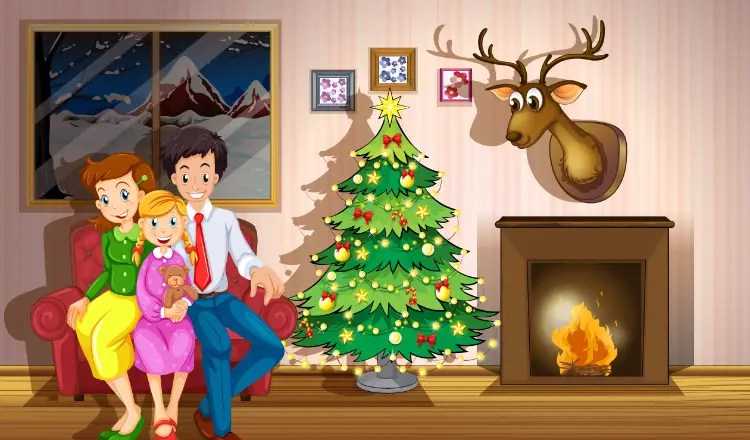
CHRISTMAS FOOD
TURKEY
The class Christmas dinner for Americans, just like with Thanksgiving, is the turkey, a tradition that actually comes from Britain. Though a roast turkey is the typical centerpiece of a Christmas dinner, other common meats include ham, beef, or pork.
EGGNOG
A classic alcohol drink for the Christmas season, besides champagne, is eggnog, a sweet drink made from eggs, cream, and sugar. It’s a strange yet popular drink among Americans and Canadians, and you can usually find the non-alcoholic mix sold at stores. Some people also make their own eggnog at home.
CANDY CANE
Different types of candy tend to be associated with different holidays. For example, Halloween is famous for its candy corn, and Valentine’s Day is the perfect holiday for giving chocolates. As for Christmas, the candy cane (also known as a “peppermint stick”) is the most famous. Traditionally, it’s a cane-shaped peppermint candy with red and white stripes, though it can now come in a variety of colors and flavors. Christians sometimes associate the candy cane with Christian symbols. For example, the cane shape represents the cane of the shepherd, either because the shepherds visited Christ as an infant, or because Christ is the “shepherd” of the people. It also looks like a letter “J,” which stands for Jesus’ name. In addition, the red color is sometimes associated with the blood of Christ, and white with the purity of faith. However, these associations come more from folklore and are not actual reasons why candy canes were invented.
GINGERBREAD MAN
A gingerbread man is a cookie made of gingerbread in the shape of a human and is a classic holiday treat that kids love to decorate with icing, chocolate, and small pieces of candy. It’s such a famous dessert, in fact, that it often appears in popular culture, especially fairy tales. For example, you’ve probably heard the story of “The Gingerbread Man,” a fairytale about a gingerbread man that came alive and ran away from its baker. The character of the gingerbread man has also appeared in The Nutcracker, the boardgame Candy Land, and the movie Shrek.
GINGERBREAD HOUSE
Sometimes, people will also build gingerbread houses along with their gingerbread men, which are usually completely covered in candy decoration and icing. The most famous example of a gingerbread house in fairy tales is the story of “Hansel and Gretel,” in which the brother and sister comes across a life-sized gingerbread house owned by a evil witch.
FRUITCAKE
Fruitcake tends to be one of the most unpopular Christmas desserts, especially among younger people, who consider it to be outdated and unappealing. Typically, it is a cake made of fruit, nuts, and spices, and are eaten around Christmastime. It’s a very rich dessert, although it may not be appearing on the dinner table too often anymore.
POPCORN STRING
You may have seen popcorn used not as a food, but as a decoration around Christmastime. In North America, some families like to string popcorn together and use it as a sort of tinsel to adorn walls or Christmas trees.
MILK & COOKIES
A favorite tradition among families with children is to leave milk and cookies out overnight on Christmas Eve by the Christmas tree. Supposedly, the milk and cookies are for Santa Claus, who likes to take snack breaks in the houses he stops by while dropping off presents. Sometimes, kids also like to leave carrots out for Santa’s reindeer.
CHRISTMAS PUDDING
Christmas pudding is more of a British tradition than an American one, but it is a common traditional dessert served as part of the Christmas dinner. Sometimes called “plum pudding” or “pud,” the dessert is full of spices and fermented fruit, therefore giving it a high alcohol content.
More for you:
How to Express Good Wishes Using MAY?
Other ways to say Happy Birthday!
CHRISTMAS CHARACTERS
SANTA CLAUS, ST. NICK, FATHER CHRISTMAS
For most people, religious or not, Santa Claus is one of the main key figures of Christmas. According to tradition, Santa is supposed to visit every home in the world on Christmas Eve to give presents to good children (and sometimes, coal to bad children). He lives in the North Pole and travels through the air on a sleigh pulled by flying reindeer, shouting his classic catchphrase, “Ho, ho, ho.”
The figure Santa Claus comes from Saint Nicholas, an actual Christian saint from modern-day Turkey, from which he also gets the name “St. Nick.” The figure may also have been derived from Norse myths, as Europe went through its process of Christianization. Today, we know Santa Claus is a fat, jolly old man with a white beard and red coat, who often visits malls to greet children and their parents. He also permeates popular culture to the point where it is almost impossible to escape him. Images of him appear in stores, movies, books, and music. Whether or not the actual Santa Claus is immortal, is legacy surely may be.
ELF
Elves appear in all types of fiction, and are usually depicted as small, human-like creatures with pointy ears and magical powers. Coming from Germanic folklore and Norse mythology, they appear in countless fictional worlds, including The Lord of the Rings, Harry Potter, and Legend of Zelda. When it comes to Christmas, though, they’re known as “Santa’s Little Helpers” and help Santa make the toys that he gives to children on Christmas Eve. In popular culture, they usually wear green uniforms and appear in movies like Rudolph, the Red-Nosed Reindeer and Elf.
REINDEER
Reindeer, also known as “caribou,” are actual animals—more specifically, they’re a species of deer that live in cold regions like the tundra and subarctic. However, they’re probably most famous for pulling Santa’s sleigh across the night sky on Christmas Eve, flying from house to house and landing on people’s roofs. According to the song, “Rudolph the Red-Nosed Reindeer,” Santa has nine reindeer total: Dasher, Dancer, Prancer, Vixen, Comet, Cupid, Donner, Blitzen, and Rudolph.
JACK FROST
Jack Frost is a folklore character inspired by cold and ice and is seen as the one who creates the nippy winter weather. Some say that he carries a paint brush and bucket to change the colors of leaves in the fall and create frost patterns on windows. Most people know his name, and he appears a lot in popular culture, especially as a cartoon character.
RUDOLPH THE RED-NOSED REINDEER
Rudolph is the famous ninth reindeer of Santa’s sleigh-pulling crew, known for his shiny red nose that other reindeer supposedly made fun of him for. You probably know his name from the song, “Rudolph the Red-Nosed Reindeer,” which explains how Rudolph joined Santa’s herd of flying reindeer. There’s also a movie named after him.
FROSTY THE SNOWMAN
While Rudolph the Red-Nosed Reindeer is a beloved Christmas character, you may have also heard of Frosty the Snowman, who also became famous through a song. The story tells about a snowman who magically came to life to play with the children who built him. There’s also a children’s movie named after him.
THE GRINCH
“How the Grinch Stole Christmas!” is a famous book written by Dr. Seuss about a bad-tempered, green character who hated Christmas celebrations. The name “Grinch” comes from the French word “grincheux,” which means “grumpy.” The Grinch is a popular character among children and, not surprisingly, has his own cartoon movie.
SCROOGE
Ebenezer Scrooge is the main character from the famous book A Christmas Carol by Charles Dickens. In the story, Scrooge is a bitter miser (a rich, stingy person) who loathes Christmas until he is visited by three ghosts: the Ghost of Christmas Past, the Ghost of Christmas Present, and Ghost of Christmas Yet to Come. Together, these ghosts convince Scrooge to become a kinder, more sympathetic man who learns to love the Christmas spirit. The book is an old Christmas classic, and the character Scrooge is so famous that the name as become its own word, meaning someone who is stingy with money.
RELIGIOUS
JESUS CHRIST
Although many people associate Christmas with Santa Claus and related traditions, Christmas is primarily a celebration of the birth of Jesus Christ. Therefore, many people attend Christmas services at church, where Christmas pageants reenacting the Nativity scene are usually staged. There are also many religious songs sung around Christmastime about the birth of Christ. The name “Christmas” comes directly from Christ’s name, meaning, “mass of Christ.”
NATIVITY SCENE
The word “nativity” refers to the birth of Jesus. Therefore, a “nativity scene” is a scene, either built as a miniature model or reenacted live, depicting the birth of Jesus. This usually includes Mary and Joseph in a stable with animals, the baby Jesus sleeping in a manger, and visitors coming to see Jesus, including shepherds and the three Magi.
BETHLEHEM
Bethlehem, a Palestinian city located in the central West Bank near Jerusalem, is the town where Jesus was born. In the Bible, Joseph and Mary were called to Bethlehem to be registered for the census. While they were there, Mary gave birth to the baby Jesus and stayed overnight in a stable (a building used for keeping animals). Today, the town is a popular tourist site, especially for pilgrimages around Christmastime.
MARY & JOSEPH
Mary and Joseph are the parents of Jesus. Although Joseph is not Jesus’ direct father, since Jesus was immaculately conceived, the Bible traces his lineage all the way back to Adam and God, making him an important genealogical figure. Mary, commonly referred to as “The Virgin Mary,” has become an extremely influential figure in Christianity, especially Catholicism, and many songs have been inspired by her, such as the famous calling, “Ave Maria,” which is Latin for “Hail Mary.” Both Mary and Joseph are typically depicted in the Nativity scene and are thus easily recognizable figures around Christmas.
HEROD
Herod was the king of Judea at the time of Jesus’ birth and was known biblically for his cruelty. For example, in his Massacre of the Innocents, he ordered the execution of all young male children near Bethlehem to protect his throne from the newborn “King of the Jews.” In the Bible, Jesus’ family fled into the Egyptian desert to escape Herod’s persecution until the king died.
MAGI, THREE WISE MEN, THREE KINGS
The Magi, also known as “The Three Wise Men” or “The Three Kings,” are a group of men sent by King Herod to visit Jesus after his birth. They’re known for bearing luxurious gifts of gold, frankincense, and myrrh and are commonly depicted in the Nativity scene. The only Gospel in the Bible to mention the Magi is Matthew, and interestingly, he never specifies their number or the fact that they were kings. These were associated with the Magi later on.
STAR OF BETHLEHEM
According to the Bible, the shepherds and the Magi were guided to Jesus by a bright star in the night sky. Because of this, the “star of Bethlehem” has become an important Christmas symbol, and is the reason why one usually places a star at the top of their Christmas tree.
MANGER
A manger is a long open box or trough used to feed animals. Jesus was supposedly born in a manger inside a stable since Mary and Joseph could not stay in an inn, and the Nativity scene usually depicts this. Nowadays, the word “manger” is more associated with the story of Christmas than actually feeding animals.
ADVENT
The Christian church year is divided into seasons, the first of which is “Advent,” which means “arrival” or “appearance.” Advent usually includes the four Sundays that lead up to Christmas and can be celebrated in church by lighting a candle every service until the coming of Christmas. The term “Advent” can also refer to the second coming of Christ.
ADVENT CALENDAR
Advent calendars are special calendars used to count down the days before Christmas. A typical Advent calendar includes flaps or windows that you can open for each day leading up to Christmas, usually starting on December 1.
NOEL
“Noel” is another word for Christmas typically used in Christmas carols and comes from the French word “noël.” The uncapitalized word can refer to a Christmas carol.
HANUKKAH
Hanukkah, also known as the “Festival of Lights,” is a Jewish holiday that usually occurs around Christmastime and therefore tends to be associated with Christmas. Hanukkah celebrates the triumph of Jewish people over religious persecution and is observed for eight nights and days. During this time, eight candles on a menorah are lit, one per day, to represent the sacred oil that miraculously lasted for eight days during the rededication of the Holy Temple during a Maccabean rebellion. The dreidel is a popular top-like toy associated with the holiday.
KWANZAA
Another holiday typically associated with Christmas is Kwanzaa, a relatively new holiday observed by many African Americans not as a religious holiday but as a celebration of African heritage and tradition. Kwanzaa is celebrated from December 26 to January 1 and was created by Maulana Karenga, a major figure in the Black Power movement, around 1966.
NEW YEAR’S DAY
The most well-known holiday associated with Christmas in New Year’s Day (also called “New Year’s” or “New Year”), celebrated on January 1. Many people throw parties on New Year’s Eve and celebrate at midnight with fireworks, drinks, and watching the Times Square Ball drop on TV. This peculiar tradition is often called “the ball drop” and follows a string of performances by famous bands and singers. Many cultures celebrate New Year’s Day on different days, such as the first day of the lunar calendar cycle.
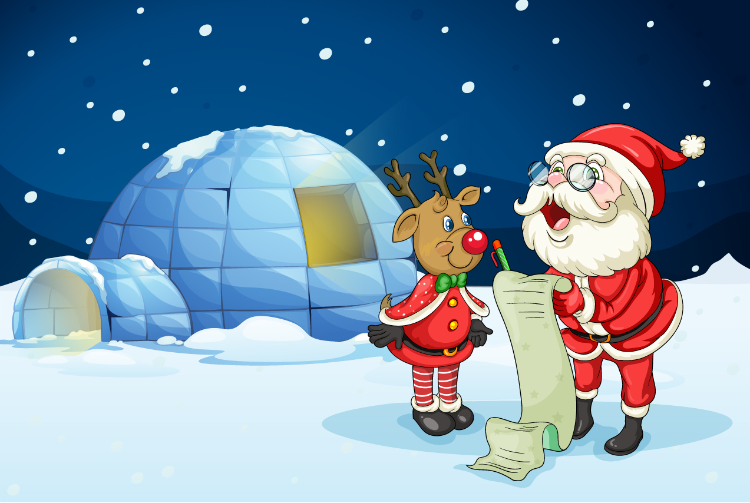
QUIZ WITH ANSWERS
- What do you call a Christmas where there is snow on the ground?
- What nickname for Santa Claus is used in the title for a song by The Beach Boys?
- Where was Jesus born?
- This holiday was invented in the ’60s to celebrate African heritage
- Santa fills these with presents, which are usually hung on walls
- What’s the name of the girl in the Nutcracker?
- What do you call the shiny stuff that hangs off of Christmas tree branches?
- Which has red berries? Mistletoe or holly?
- What is a shortened term for “Christmas”?
- This figure of folklore is known for painting frost on people’s windows
- How many magi were there?
- What word is an old term for “Christmas” that comes from French?
- What’s another term for “Christmas song”?
- This alcoholic drink is made from eggs and cream
- Who is the main character of A Christmas Carol by Charles Dickens?
- What’s the name of Mariah Carey’s famous Christmas hit from 1994?
- True or false: Candy canes are shaped like canes to represent the canes of the shepherds who saw the baby Jesus.
- This word refers to the period leading up to Christmas
- This is a North American term for “reindeer”
- This Christmas plant is famous from Mexican folklore
- What’s the name of the snowman who magically came to life?
- What do you call a trough that animals eat out of?
- Which reindeer has a shiny red nose?
- Fill in the blank: “On the first day of Christmas, my true love gave to me a _____ in a pear tree.”
- What snack do children usually leave out for Santa?
ANSWERS
- White Christmas
- St. Nick
- Bethlehem
- Kwanzaa
- Stockings
- Carla
- Tinsel
- Holly
- Xmas
- Jack Frost
- Three (though this isn’t mentioned in the Bible)
- Noël
- Christmas carol
- Eggnog
- Ebenezer Scrooge
- “All I Want For Christmas Is You”
- Technically false. This explanation of origin comes from folklore.
- Advent
- Caribou
- Poinsettia
- Frosty the Snowman
- Manger
- Rudolph the Red-Nosed Reindeer
- Partridge
- Milk and cookies
More for you:
Other ways to say Good Luck!
Travel, Packing, Booking Vocabulary and Dialogs in English
CHRISTMAS CAROLS
How many of these songs do you know in English?
RELIGIOUS
O Come, All Ye Faithful
“O come, all ye faithful
Joyful and triumphant
O come ye, O come ye to Bethlehem
Come and behold Him
Born the King of Angels
O come, let us adore Him…”
— Originally “Adeste Fideles,” written around the 17th or 18th centuries
While Shepherds Watched Their Flocks
“While shepherds watched their flocks by night
All seated on the ground
The angel of the Lord came down
And glory shone around…”
— Dates back to 1700
Joy to the World
“Joy to the World, the Lord is come
Let Earth receive her King
Let every heart prepare Him room
And Heaven and nature sing…”
— Published in 1719, based on Psalm 98
Hark! The Herald Angels Sing
“Hark! The herald angels sing
Glory to the new-born King
Peace on Earth and mercy mild
God and sinners reconciled”
— Published in 1739, written by Charles Wesley
God Rest Ye Merry Gentlemen
“God rest ye merry gentlemen, let nothing you dismay
Remember Christ the Savior was born on Christmas day
To save us all from Satan’s power when we had gone astray
Oh, tidings of comfort of joy…”
— Published c. 1760, though it dates to the 16th century or earlier
Silent Night
“Silent night, holy night
All is calm, all is bright
Round yon Virgin Mother and Child
Holy infant so tender and mild
Sleep in heavenly peace…”
— Composed by Franz Xaver Gruber in 1818
The First Noel
“Noel, Noel, Noel, Noel
Born is the King of Israel”
— Published in 1823
Once In Royal David’s City
“Once in royal David’s city
Stood a lowly cattle shed
Where a mother laid her Baby
In a manger for His bed
Mary was that mother mild
Jesus Christ, her little Child”
— Published in 1848, originally a poem by Cecil Frances Alexander
It Came Upon the Midnight Clear
“It came upon midnight clear
That glorious song of old
From angels bending near the earth
To touch their harps of gold”
— Written by Edmund Sears in 1849
Good King Wenceslas
“Good King Wenceslas looked out
On the Feast of Stephen
When the snow lay ‘round about
Deep and crisp and even”
— Written by John Mason Neale in 1853
We Three Kings
“We three kings of Orient are
Bearing gifts, we traverse far
Field a mountain, moor and mountain
Following yonder star”
— Written by John Henry Hopkins, Jr. in 1857
Angels We Have Heard On High
“Angels we have heard on high
Singing sweetly through the night
And the mountains in reply
Echoing their brave delight
Gloria, in Excelsis Deo…”
— Translated from French into English in 1862
What Child Is This?
“What Child is this who laid to rest
On Mary’s lap is sleeping?
Whom Angels greet with anthems sweet
While shepherds watch are keeping?”
— Written by William Chatterton Dix in 1865
O Little Town of Bethlehem
“O little town of Bethlehem
How still we see thee lie
Above thy deep and dreamless sleep
The silent stars go by”
— Written by Phillip Brooks c. 1868
Away in a Manger
“Away in a manger, no crib for His bed
The little Lord Jesus lay down His sweet head”
— Published in 1885
Ding Dong Merrily on High
“Ding dong, merrily on high
In heav’n the bells are ringing
Ding dong, verily the sky
Is riv’n with angels singing”
Gloria, Hosanna in Excelsis!”
— Published in 1924, lyrics by George Ratcliffe Woodward
The Little Drummer Boy
“Come they told me, pa rum pum pum pum
A new born king to see, pa rum pum pum pum”
— Written by Katherine Kennicott Davis in 1941
Do You Hear What I Hear
“Said the little lamb to the shepherd boy,
Do you hear what I hear?
Ringing through the sky, shepherd boy,
Do you hear what I hear?
A song, a song high above the trees
With a voice as big as the sea…”
— Written by Gloria Shayne Baker and Noël Regney in 1962
Download for free:
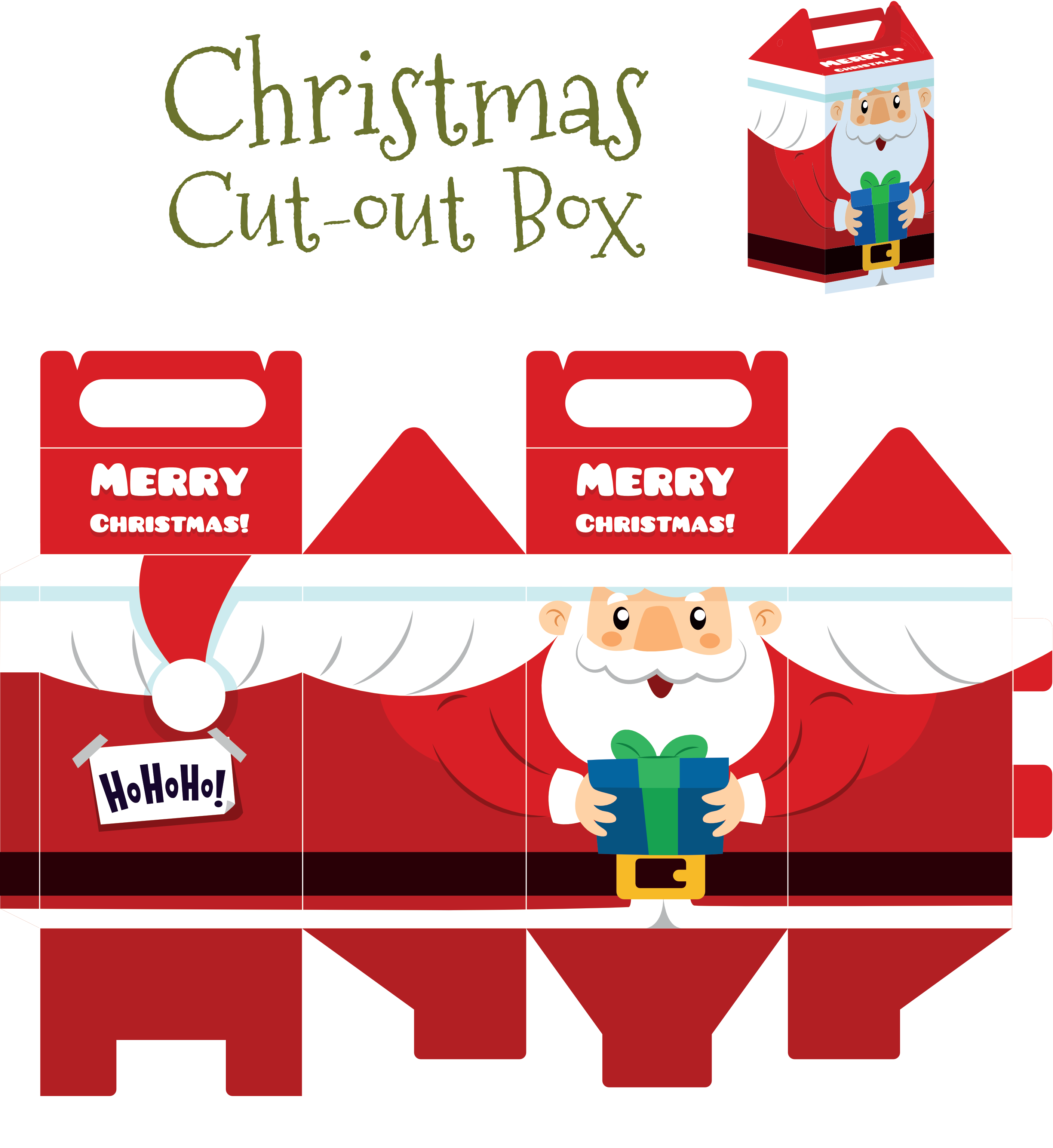
NON-RELIGIOUS
Twelve Days of Christmas
“One the first day of Christmas, my true love gave to me
A partridge in a pear tree”
— Published in 1780 without music
Deck the Halls
“Deck the halls with boughs of holly
Fa, la, la, la, la, la, la, la, la!
‘Tis the season to be jolly,
Fa, la, la, la, la, la, la, la, la!”
— Old Welsh melody published as a carol in 1794 (English lyrics from 1862)
O Christmas Tree
“O Christmas tree, o Christmas tree
How lovely are thy branches”
— From the German song “O Tannenbaum,” published in 1824
Jingle Bells
“Jingle bells, jingle bells
Jingle all the way
Oh, what fun it is to ride
In a one horse open sleigh”
— Originally published as “One Horse Open Sleigh” in 1857
Winter Wonderland
“Sleigh bells ring, are you listening?
In the lane, snow is glistening
A beautiful sight, we’re happy tonight
Walking in a winter wonderland”
— Written by Felix Bernard and Richard B. Smith in 1933
Santa Claus is Coming to Town
“You better watch you, you better not cry
You better not pout, I’m telling you why
Santa Claus is coming to town”
— Written by John Frederick Coots and Haven Gillespie in 1934
We Wish You a Merry Christmas
“Good tidings we bring
To you and your kin
We wish you a Merry Christmas
And a Happy New Year”
— Published in 1935, though may have been older
Rudolph the Red-Nosed Reindeer
“Rudolph the Red-Nosed Reindeer
Had a very shiny nose
And if you ever saw it
You would even say it glowed”
— Written by Johnny Marks in 1939
White Christmas
“I’m dreaming of a white Christmas
Just like the ones I used to know
Where the treetops glisten and children listen
To hear sleigh bells in the snow”
— Written by Irving Berlin in 1942
Have Yourself a Merry Little Christmas
“Have yourself a merry little Christmas
Let your heart be light
From now on our troubles will be out of sight”
— Judy Garland, 1944
The Christmas Song (Chestnuts Roasting On An Open Fire)
“Chestnuts roasting on an open fire
Jack Frost nipping at your nose
Yuletide carols being sung by a choir
And folks dressed up like Eskimos”
— Written by Bob Wells and Mel Tormé in 1945
Let It Snow! Let It Snow! Let It Snow!
“Oh, the weather outside is frightful
But the fire is so delightful
And since we’ve no place to go
Let it snow, let it snow, let it snow”
— Vaughn Monroe, 1945
Here Comes Santa Claus
“Here comes Santa Claus
Here Comes Santa Claus
Right down Santa Claus lane”
— Gene Autry, 1947
Carol of the Bells
“Hark how the bells
Sweet silver bells
All seem to say
Throw cares away”
— Based on a Ukrainian folk chant, lyrics written in 1914
Sleigh Ride
“Just hear those sleigh bells jingling
Ring-ting-tingling too
Come on, it’s lovely weather
For a sleigh ride together with you”
— Originally an orchestral piece by Leroy Anderson in 1948, lyrics by Mitchell Parish in 1950
I Saw Mommy Kissing Santa Claus
“I saw Mommy kissing Santa Claus
Underneath the mistletoe last night
She didn’t see me creep
Down the stairs to have a peep
She thought that I was tucked up
In my bedroom, fast asleep”
— Jimmy Boyd, 1952
Jingle Bell Rock
“Jingle bell, jingle bell, jingle bell rock
Jingle bell swing and jingle bells ring
Snowing and blowing up bushels of fun
Now the jingle hop has begun”
— Bobby Helms, 1957
Rockin’ Around the Christmas Tree
“Rockin’ around the Christmas tree
Have a happy holiday
Everyone dancing merrily
In the new old-fashioned way”
— Brenda Lee, 1958
Little St. Nick
“Well, way up north where the air gets cold
There’s a tale about Christmas that you’ve all been told
And a real famous cat all dressed up in red
And he spends the whole year workin’ out on his sled
It’s the little Saint Nick”
— The Beach Boys, 1963
It’s the Most Wonderful Time of the Year
“It’s the most wonderful time of the year
With the kids jingle belling
And everyone telling you, be of good cheer
It’s the most wonderful time of the year”
— Andy Williams, 1963
A Holly Jolly Christmas
“Have a holly, jolly Christmas
It’s the best time of the year
I don’t know if there’ll be snow
But have a cup of cheer”
— Burl Ives, 1965
Christmas Time is Here
“Christmas time is here
Happiness and cheer
Fun for all that children call
Their favorite time of year”
— Written in 1965 for A Charlie Brown Christmas
Feliz Navidad
“Feliz navidad
Feliz navidad
Feliz navidad, prospero año y felicidad”
— José Feliciano, 1970
All I Want for Christmas Is You
“I don’t want a lot for Christmas
There is just one thing I need
I don’t care about the presents
Underneath the Christmas tree
I just want you for my own
More than you could ever know
Make my wish come true
All I want for Christmas is you”
— Mariah Carey, 1994
More for you:
Formal and Informal Email Phrases Starting with Greetings
6 Ways to Immediately Improve Your English Communication Skills



